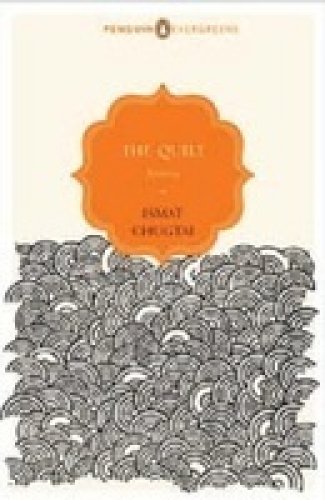The Quilt & Other Stories
Ismat Chughtai and M. Asauddin (tr)
Chughtai, Ismat; M. Asauddin (tr);
The Quilt & Other Stories [Lihaaf]
Penguin Evergreens 2001, 149 pages
ISBN 9780143416005
topics: | fiction | india | urdu | translation | | |
Bold islamist feminist fiction from the 1940s
the stories are related with an intimacy and an innocence that undercuts their often adult themes. several stories are related by a girl who has just reached puberty, and is told in a language free of guile. The stories impress in their subtle craftsmanship, raising deep issues with a gentle touch.
the opening story, gainda, tells of a relative of the young protaonist (maybe a cousin), gainda, who has been recently widowed, but is barely a couple of years older to her. the story tells of them secretly playing bride-groom, by lifting the ghunghat and exploring the first gaze of the husband. gainda, who is more experienced, treats her as an innocent. at the same time, her elder brother, bhaiyA, whom they are scared of, is forever trying to touch or press gainda. one day she observes gainda slapping this fearsome elder brother, but nothing happens to her.
eventually she goes off to stay with an aunt for two years. when she returns, she finds that gainda has had a baby. when her sister-in-law had had a child there were such celebrations, but now gainda is beaten up and she and her baby are sent off to live by herself in a hut while bhaiyA is sent to the city for higher studies.
The quilt
the quilt (lihaaf) is also related from the point of view of a young girl, also just past puberty: "At my age, my other sisters were busy drawing admirers, while I fought with any boy or girl I ran into." When her mother leaves to visit agra for a week, she is put up as a companion for a nawab's begum.
the begum jaan is a beautiful woman from a poor family, who was married to an old nawab. society considers him very virtuous - "no one had ever seen a nautch girl or a prostitute in his house." he is known for helping young scholars, who roam the house in their "perfumed, flimsy shirts", a passion described with a very light touch. Begum Jaan is ignored and grows frail, until she is rescued by the servant girl Rabbu, who massages her back to health.
the path-breaking tale (published 1941) relates the relationship between the
begum and rabbu, as witnessed by the young protagonist. rabbu, who is as
dark as the begum was fair, has a face pockmarked by smallpox. she is
the begum's masseur, and has no other job in the household.
the innocent child is in love with the beautiful begum, and is initially
thrilled to be with her. she is given a bed beside the begums. even at
night, rabbu is massaging her, well past the time when the child falls
asleep. late at night, she is awakened by the sounds of the quilt heaving on
the begum's bed - as though an elephant were struggling inside. there are
sounds of heavy licking; she thinks that perhaps rabbu is eating something.
when she expresses alarm the heaving stops - the begum's voice - coming as
if from somewhere far away, tells her to go back to sleep - perhaps she can
recite the ayatul kursi until asleep. but she is scared.
the next day rabbu has to go for a family errand, and the begum is
despondent. eventually, the child starts to massage the begum, and
suddenly finds her hands guided into strange places. then the begum tries
to count her ribs, making her uncomfortable. eventually she presses her
tightly, and does not let her go, and her eyes have a glazed look.
in the end the begum breathes heavily and lies back and she runs out of the
room.
after rabbu comes back, she is initially jealous of the child, but soon
resumes her old position. the elephant under the quilt starts up again.
the child is very scared, and at night, she decides to switch on the
light.
I stretched my leg nervously to the other side of the bed to grope for
the switch and turned it on. The elephant somersaulted inside the quilt
which deflated immediately. During the somersault the corner of the quilt
rose by almost a foot...
Good God! I gasped and plunged into my bed.
Obscenity trial 1944
the short story lihaaf -- the word also has connotations of concealment -- was the fulcrum of a wave of opprobrium in pre-independent India's muslim society. When published in the literary journal adab-i-latif, the paper was flooded with angry letters. Ismat was called upon to apologize, but she refused. Conservatives filed an obscenity trial at the Imperial Crown court in Lahore (1944). Ismat's lawyer argued that there were no text in the story that was obscene, and that homoeroticity was never directly alluded to. the case was judged in her favour. (see times of india) today, the story is on the syllabus at delhi university. read this very translation of lihaaf at manushi-india
Contents
Gainda 1a The Quilt 15 The Mole 28 The Homemaker 45 Touch-me-not 64 Quit India 71 All Alone 91 The Invalid 109 Mother-in-law 117 Roots 126 --bio The first Muslim woman in India to obtain both a B.A. and a teaching degree, Ismat Chughtai (1915-1991) revolutionized Urdu literature. Her best-known and erotically charged work "The Quilt" exposed the relationship between a privileged woman and her maid, and touched off an obscenity trial that lasted four years. * see the elegant short film, lihaaf (in english): Lihaaf (youtube, 20 min) * Review by Kishwar Desai in The Independent: Book of a lifetime * quotes from chughtai's autobiography at amardeep singh's blog
amitabha mukerjee (mukerjee [at-symbol] gmail) 2012 Nov 07
